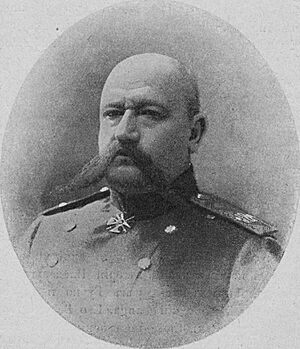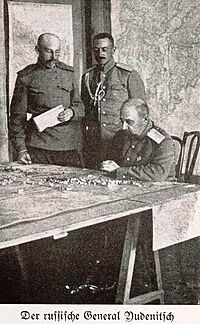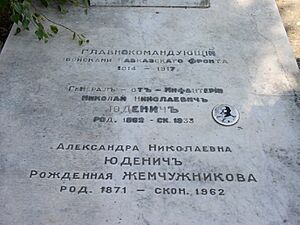Nikolai Yudenich facts for kids
Quick facts for kids
Nikolai Yudenich
|
|
|---|---|

Yudenich, c. 1916
|
|
| Native name |
Николай Николаевич Юденич
|
| Born | 30 July 1862 Moscow, Moskovsky Uyezd, Moscow Governorate, Russian Empire |
| Died | 5 October 1933 (aged 71) Saint-Laurent-du-Var, France |
| Buried | |
| Allegiance | |
| Service/ |
|
| Years of service | 1879–1919 |
| Rank | General of the Infantry |
| Commands held | Russian Caucasus Army |
| Battles/wars |
|
| Awards | See below |
Nikolai Nikolayevich Yudenich (born July 30, 1862 – died October 5, 1933) was an important general in the Russian Imperial Army during World War I. He also led the White movement, a group that fought against the communists, during the Russian Civil War in northwestern Russia.
Contents
Early Life and Military Training
Nikolai Yudenich was born in Moscow. His father worked as a minor official for the government. Nikolai went to the Alexandrovsky Military College, finishing in 1881. He then studied at the General Staff Academy, graduating in 1887.
Early Military Career
Yudenich began his army career in Lithuania. He served with the Life Guards Regiment from 1889 to 1890. In 1892, he moved to the Turkestan Military District. He was promoted to lieutenant colonel that same year. In 1894, he was part of an expedition to the Pamir Mountains. He became a colonel in 1896.
Fighting in the Russo-Japanese War
In 1902, Yudenich became the commander of the 18th Infantry Regiment. He led this regiment during the Russo-Japanese War (1904–1905). He was injured twice during this war. He was wounded in the arm at the Battle of Sandepu. Later, he was wounded in the neck at the Battle of Mukden. After the war, he was promoted to major general.
Rising Through the Ranks
From 1907, Yudenich worked at the General Staff of the Caucasus Military District. He was promoted to lieutenant general in 1912. In 1913, he became the chief of staff for the Caucasus Military District.
World War I: Leading the Caucasus Army
When World War I began, Yudenich was made Chief of Staff of the Russian Caucasus Army. He played a key role in major battles.
Victories in the Caucasus Campaign
One big victory was the Battle of Sarikamish. Here, his army defeated the Ottoman Empire's forces. In January 1915, Yudenich was promoted to General of Infantry. He then took command of the entire Caucasus Campaign.
Yudenich tried to use this victory to push into Turkish land. His forces captured Van in May 1915. However, they had to leave the city two months later. The Ottoman army then took Van back in August.
Working with Grand Duke Nicholas
Grand Duke Nicholas was later put in charge of the Caucasus front. He gave Yudenich a lot of freedom to make decisions. In September, the Russians recaptured Van. They also set up a new government in Western Armenia. Fighting continued for over a year without a clear winner.
Major Offensives of 1916
In 1916, Yudenich led successful attacks. His forces won the Battle of Erzurum (1916) and the Trebizond Campaign. Later that summer, his army fought off a Turkish counterattack. This led to the Battle of Erzincan. During this battle, Yudenich received the Order of St. George (2nd degree). This was one of the highest honors in the Russian Empire.
After the February Revolution
After the February Revolution in 1917, Yudenich became commander of the Caucasus Front. But in May, the new Russian government removed him from command. They said he was disobedient. He was ordered to retire from the army. Yudenich then moved to Petrograd. He supported the Kornilov revolt, which was an attempt to stop the revolution.
White Army: Fighting the Bolsheviks
After the October Revolution in 1917, the Bolsheviks took power. Yudenich went into hiding. He was helped by a former soldier who had served with him. In January 1919, he managed to escape to Finland.
Leading the White Movement
In Helsinki, Yudenich joined the "Russian Committee." This group had formed to fight the Bolsheviks. Yudenich was named the leader of the White movement in northwestern Russia. He was given full power. In the spring of 1919, Yudenich visited Stockholm. He met with officials from Britain, France, and the United States. He tried to get help to form a volunteer army to fight the Bolsheviks.
Support from Admiral Kolchak
In June 1919, Yudenich connected with Admiral Aleksandr Kolchak. Kolchak's government was based in Omsk. Kolchak recognized Yudenich as the commander-in-chief of all Russian forces fighting the Bolsheviks in the Baltic Sea area. Kolchak also sent money to help pay and equip Yudenich's army.
Preparing for Battle
In August 1919, Yudenich formed the "Regional Government of Northwest Russia." This government included different groups who opposed the Bolsheviks. Yudenich served as the Minister of War. He spent two months organizing and training his army. By September 1919, he had about 17,000 soldiers, 53 guns, and six tanks. Britain supplied the tanks and their volunteer crews.
Attack on Petrograd
In early October 1919, Yudenich launched his army toward Petrograd. The city was not well defended at first. The Red Army was busy fighting on other fronts. Yudenich's friend, General Carl Gustav Emil Mannerheim, asked the Finnish President to join Yudenich's attack. Yudenich would have recognized Finland's independence. However, Kolchak would not recognize Finland's independence. So, the Finnish President refused Mannerheim's request.
On October 12, 1919, the White forces recaptured Yamburg. Two days later, Yudenich was near Gatchina. By October 19, his troops reached the edge of Petrograd. But they failed to capture the important railway line to Moscow. This allowed the Red Army to send many more soldiers to defend the city. Yudenich's attack stopped in late October. The Red Army pushed his troops back into Estonia in November.
The Estonian army did not trust the White Russians. They disarmed and held the remaining White Army soldiers. The Bolsheviks then made a separate peace with Estonia. They promised to recognize Estonia's independence. This was different from the White Army's position.
Worthless Currency
During the civil war, Yudenich printed money to pay his soldiers. This money became almost worthless. A chocolate company in Tallinn even asked if they could use the banknotes as wrappers for their products.
On January 28, 1920, Yudenich was arrested. This happened as he tried to escape to Western Europe. He was later released from prison.
Later Life and Legacy
After his release, Yudenich went to live in France. He spent his remaining 13 years there. He did not play a major role among the Russian people who had also left Russia.
Nikolai Yudenich died on October 5, 1933, near Nice, France.
Honors
Order of St. Stanislaus 3rd degree, 1889
 Order of St. Anne 3rd degree 1893
Order of St. Anne 3rd degree 1893Order of St. Stanislaus 2nd degree 1895
 Order of St. Anne 2nd degree 1900
Order of St. Anne 2nd degree 1900 Order of St Vladimir, 4th degree, 1904
Order of St Vladimir, 4th degree, 1904 Order of St Vladimir, 3rd degree with swords, 1906
Order of St Vladimir, 3rd degree with swords, 1906Order of St. Stanislaus 1st degree with swords, 1906
- Gold Sword for Bravery, 1906
 Order of St. Anne 1st degree 1909
Order of St. Anne 1st degree 1909 Order of St Vladimir, 2nd degree with swords, 1913
Order of St Vladimir, 2nd degree with swords, 1913 Order of St. George, 4th class, 1916
Order of St. George, 4th class, 1916 Order of St. George, 3rd class, 1916
Order of St. George, 3rd class, 1916 Order of St. George, 2nd class, 2 February 1916
Order of St. George, 2nd class, 2 February 1916




